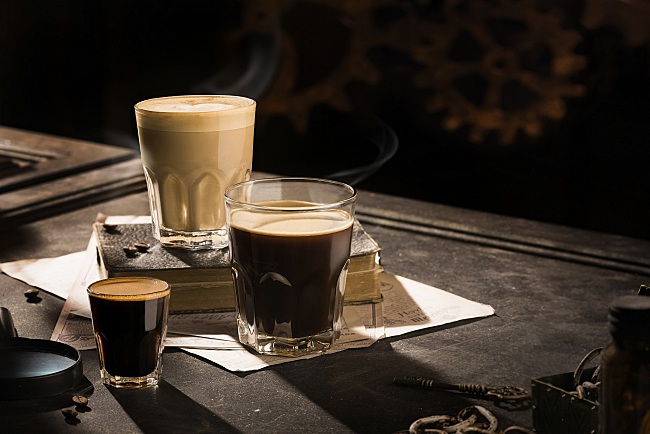Why SOE Single Origin Espresso Is Loved Among Baristas
Why SOE Single Origin Espresso Is Loved Among Baristas
Blog Article
Recognizing Coffee Beans: the Journey From Coffee to Blended Coffee Beans

The Origins of Coffee: A Global Perspective
While you might consider coffee as a modern staple, its origins map back centuries, intertwining with societies across the world. The story begins in Ethiopia, where tale claims a goat herder named Kaldi found the stimulating effects of coffee beans after seeing his goats frolicking vigorously after consuming them. This triggered rate of interest, leading to coffee's infect Arab investors who treasured the brewed beverage. By the 15th century, it reached Persia, Egypt, and Turkey, where coffeehouses came to be social centers for discussion and culture.
As trade paths increased, coffee made its way to Europe in the 17th century, promptly gaining appeal. It transformed from a mystical beverage into a day-to-day routine, intellectual exchanges and inspiring events. Each culture added its unique spin to coffee preparation, enriching its background. This worldwide journey highlights just how coffee attaches us, transcending borders and unifying diverse traditions via a basic bean.
Farming and Harvesting of Espresso Beans
As coffee's journey progressed, the focus shifted to the cultivation and harvesting of certain bean ranges, especially those utilized for espresso. You'll find that espresso beans frequently originate from Arabica or Robusta plants, each offering distinctive flavors. The suitable expanding problems consist of high altitudes and abundant, well-drained soil, which enhance the beans' top quality.
Throughout the harvest, choosing methods vary. In some areas, employees hand-pick ripe cherries, guaranteeing only the best fruit mosts likely to processing. In various other areas, mechanical harvesters are utilized, especially on bigger ranches. Timing is vital; you intend to collect when the cherries reach peak ripeness for maximum taste.
As soon as gathered, the beans are planned for processing, which is important in determining their final taste. Comprehending the cultivation and gathering procedures offers you understanding right into what goes into your favorite espresso, enriching your recognition for each and every cup.
Processing Techniques: From Cherry to Bean
Currently that you have actually discovered gathering espresso beans, let's explore how those cherries change right into the coffee beans you enjoy. You'll see how various harvesting strategies influence taste, followed by the important steps of fermentation and drying out. Finally, we'll damage down the milling and grading process that establishes your coffee's high quality.
Harvesting Methods Described
When it involves coffee, recognizing harvesting techniques is essential, since they straight influence the flavor and top quality of the beans you delight in. There are two primary approaches: selective picking and strip selecting. Discerning choosing involves hand-picking only ripe cherries, ensuring you obtain the ideal high quality beans. This method typically results in a richer flavor profile, though it's even more labor-intensive. On the other hand, strip picking ways collecting all cherries at the same time, no matter of perfection. While it's quicker and less expensive, this can result in a mix of flavors, impacting the final product. Eventually, the selection of collecting method can considerably influence your coffee experience, so it's worth knowing how those beans made it to your mug.
Fermentation and Drying Out
After harvesting, the next action in handling coffee beans play a substantial role in shaping their taste. You'll locate that fermentation is vital, as it helps break down the mucilage bordering the beans, enhancing their taste profile. Depending upon the approach, this procedure can last from a few hours to a number of days, with differing results based upon temperature and humidity.
Sun-drying permits the beans to take in flavors from the setting, while mechanical drying out warranties regular moisture degrees regardless of weather. Appropriate drying is essential to protect against mold and maintain the beans' high quality, eventually affecting your cup of coffee.
Milling and Grading Refine
As fermentation and drying set the phase for taste advancement, the milling and grading process warranties that only the finest coffee beans make it to your mug. This phase entails removing the outer layers of the coffee cherry, consisting of the parchment and husk. After milling, the beans are arranged by dimension and weight, guaranteeing an uniform top quality. You'll find that grading helps recognize flaws and classify beans, which influences flavor and fragrance. Top notch beans receive a higher grade, resulting in a richer coffee experience. When graded, the beans are ready for product packaging and shipping, preserving their one-of-a-kind qualities. This precise process is vital for supplying the remarkable taste you enjoy in every sip of your favored brew.
Roasting Strategies: Unlocking Flavor Possible
When you roast coffee beans, the approach you pick can dramatically affect the flavor profile. Understanding the relationship in between time, temperature, and roasting methods is crucial to exposing the potential of your mixture. Let's explore how these components collaborated to create the excellent mug.
Toasting Approaches Discussed
While you might assume that all coffee toasting techniques yield the very same outcomes, the fact is that each method reveals unique taste capacities in the beans. You can choose between approaches like drum toasting, air roasting, and even conventional frying pan roasting. Drum toasting utilizes a turning drum to evenly distribute warm, improving caramelization and producing a well balanced flavor. Air roasting, on the various other hand, circulates warm air around the beans, advertising a lighter roast with obvious level of acidity. Frying pan toasting enables hands-on control but requires constant focus to prevent burning. Each method has its subtleties, so try out various techniques can help you find the excellent roast that straightens with your taste choices. Appreciate the trip of locating your excellent mug!

Influence On Taste Profile
Various roasting approaches not just influence the procedure but also considerably affect the flavor account of the coffee beans. Dark roasts, on the various other hand, bring out strong, great smoky tastes, often masking the bean's one-of-a-kind qualities. Comprehending these subtleties aids you appreciate the virtuosity behind your cup of coffee, improving your general experience with every sip.
Time and Temperature Factors
To launch the complete taste potential of coffee beans, both time and temperature level throughout the toasting procedure play significant roles. When toasting, you'll locate that greater temperatures can rapidly develop tastes, but if you rush it, you may wind up with scorched notes. Alternatively, reduced temperatures permit for an extra steady flavor growth, showcasing the beans' distinct characteristics.

Timing is equally as vital; expanding the roast as well long can bring about a loss of level of acidity and brightness, while also short a roast could leave the beans underdeveloped. Discovering that sweet place requires method and testing. By changing these elements, you can expose the abundant, intricate tastes concealed within each bean, creating an absolutely remarkable coffee experience.
The Art of Blending: Crafting One-of-a-kind Coffee Profiles

Start by choosing a base coffee that offers a strong foundation. A brilliant Ethiopian bean can bring fruitiness, while a rich Brazilian coffee includes body.
As you blend, remember that each mix informs a tale. You're not simply making coffee; you're developing an experience. So, take your time, preference regularly, and delight in the trip of finding your signature blend.
Brewing Methods: How Prep Work Impacts Flavor
Blending coffee opens up a domain of flavor possibilities, but exactly how you brew that blend can considerably influence your last mug. Various developing methods extract unique flavors and scents, so it's critical to pick intelligently. For example, a French press enables oils and sediments to remain, developing an abundant, robust experience. On the various other hand, a pour-over highlights the coffee's quality and brightness, perfect for showcasing click over here now fragile notes.
Espresso, with its high stress, generates a concentrated shot that highlights sweet taste and crema. If you choose a lighter brew, take into consideration a cold mixture news method; it produces a smooth, less acidic taste.
Changing variables like water temperature level, grind size, and make time can change your coffee's profile. Accept the art of developing to find the tastes hidden in your coffee blends.
The Future of Coffee: Sustainability and Innovation
As the coffee market advances, sustainability and advancement are ending up being vital for resolving ecological difficulties and meeting consumer needs. You'll see that more coffee firms are adopting environmentally friendly practices, from sourcing beans morally to applying sustainable farming methods. These shifts not just aid the earth but likewise boost the high quality of the coffee you enjoy.
You may see technologies like eco-friendly product packaging and water-saving developing techniques that lower waste. Advanced technology, such as blockchain, is likewise coming to be popular, guaranteeing openness in the supply chain, which enables you to trace your coffee back to its origins.
On top of that, buying regional areas and sustaining farmers with fair trade efforts fosters a much more lasting coffee ecological community. As you sip your following cup, keep in mind that your options can add to a brighter future for coffee. By selecting lasting brands, you're not simply enjoying a drink; you're making a favorable influence on the globe.
Regularly Asked Questions
What Is the Difference Between Arabica and Robusta Beans?
Arabica beans are smoother, sweeter, and have a greater acidity, while robusta beans are stronger, much more bitter, and consist of even more high levels of caffeine. You'll observe these distinctions in taste and aroma when making your coffee.
Exactly How Does Elevation Affect Coffee Bean Flavor?
Elevation effects coffee bean flavor significantly. Higher elevations produce beans with brighter acidity and complex tastes, while lower elevations usually produce beans that are larger and much less nuanced. You'll notice these differences in your mug!
What Are the Wellness Benefits of Alcohol Consumption Coffee?
Drinking coffee can increase your energy, boost mental emphasis, and also improve physical performance. It's rich in anti-oxidants, may lower the threat of particular illness, and can promote a much healthier metabolic rate when eaten in moderation.
Can Coffee Beans Be Reused for Developing?
Yes, you can recycle coffee beans for brewing, however the flavor may be weaker. If you enjoy exploring, attempt reusing them in various means, like cold brews or contributing to smoothies for an extra kick.
Exactly how Should I Store Coffee Beans for Quality?
To maintain your coffee beans fresh, store them in an impermeable container in a cool, dark location. Stay clear of exposing them to wetness, warmth, or light, as these variables can swiftly find out here weaken their flavor and aroma.
Understanding Coffee Beans: the Journey From Espresso to Blended Coffee Beans.
Currently that you have actually discovered regarding gathering coffee beans, allow's explore how those cherries change into the coffee beans you love.When you roast coffee beans, the technique you pick can considerably influence the flavor profile - Single Origin Espresso.While you might believe that all coffee toasting methods yield the exact same outcomes, the truth is that each method reveals special flavor capacities in the beans.Various roasting methods not only influence the process yet also significantly influence the flavor profile of the coffee beans
Report this page